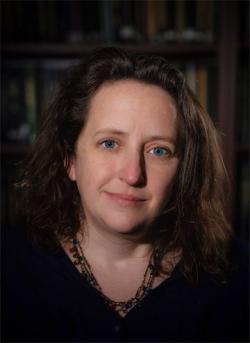The idea was simple: Physically connect people with the locations of the May 4, 1970, Kent State University shootings so they might better connect with each other.
From this notion, two Kent State professors began a research project that blossomed into Mapping May 4, an interactive web app that connects specific May 4 locations to sections of oral histories from May 4 witnesses and others and serves as a navigation device for those walking the May 4 site. Those using the app can also comment on stories and record and add their own stories to the project.
Now, four years since its debut, Mapping May 4 continues to expand, offering an even broader view of what that fateful day was like for so many on the Kent Campus and the larger Kent community.
On May 4, 1970, the Ohio National Guard fired on students protesting the escalation of the war in Vietnam, killing four students, and wounding nine others.
Sara Koopman, Ph.D., assistant professor in the School of Peace and Conflict Studies, and Jennifer Mapes, Ph.D., associate professor of Geography, began their project by reviewing all the oral histories that have been recorded for the May 4 Collection in the University Libraries’ Special Collections and Archives.

In 2021, a large interactive map of Kent as it was in 1970, was installed on a wall outside the May 4 Visitors Center inside Taylor Hall. The map includes recorded narratives, which visitors can push a button to hear.
Mapes and Koopman used a reverse city directory from 1970 to gather the names of the businesses in Kent at the time to add them to their locations on the map.
For those walking the May 4 sites, including markers for the slain and injured students, the app performs as a navigational device, leading visitors to various locations and allowing them to listen to witness narratives as they walk.
Since its debut, there have been 10,000 visitors to the Mapping May 4 site, from 88 different countries, Mapes said.

“It has attracted a lot of interest from a lot of different places. People are putting it on course syllabuses and using it for teaching and using it as an example of how to work with oral histories and share oral histories in a way that might get attention from a wider audience of people,” she said. By including just snippets of stories, the pair hope to reach an audience who otherwise would not take the time to listen to complete oral histories.
One of the biggest challenges has been keeping up with new oral histories that continue to be added to the Libraries Special Collections, and the pair have recruited students to help with that effort. So far, more than 300 stories have been added to the website from the oral histories, Mapes said.
The app includes several self-guided walking tours. A new tour, this year, focuses on stories from the dorms.
In the future, Koopman said she hopes to install signs with QR codes around the various May 4 sites to take visitors directly to the Mapping May 4 site on their phones to help make the app more accessible.
“The idea would be to scan the QR code and get right to the stories from that location,” she said.
Koopman said an important goal of the project was for the narratives to engage people in listening to the stories of others and hopefully “to find connections across differences, to build compassion for very different experiences that they wouldn’t necessarily have compassion for.”
“I’m sure there were some people who would never listen to a guardsman’s story and other people who would never listen to the story of a student activist who was on the front lines,” Koopman said.
As a peace and conflict studies professor who has conducted much work on reconciliation in various contexts, Koopman said, “Being able to see the humanity in each other is one of the difficulties after an atrocity like ours.”
Both professors are interested in understanding how cities can recover from tragedies and experience reconciliation and were looking for ways to create dialogues and get people to understand multiple perspectives in the aftermath, Mapes said.
“I’m hoping it has been therapeutic for people too because this is a major trauma for folks that really shaped their lives for a long time,” Koopman said.
“Mapping May 4: Walking Tour Dialogues”
From 3-4 p.m. on Saturday, May 4, and 11 a.m.-noon on Sunday, May 5, Koopman and Mapes will lead an hour-long walking tour through parts of the Kent Campus and downtown Kent. The tour's goal is to engage participants in dialogue about April 30-May 5, 1970. The tour will stop at key locations and participants will view historic photos and maps and listen to stories that reflect multiple perspectives of the 1970 events, to engage participants in a thoughtfully facilitated discussion of their reactions, memories and reflections on May 4 events. The tour will depart from the front steps of McGilvrey Hall, facing Lincoln Street.

